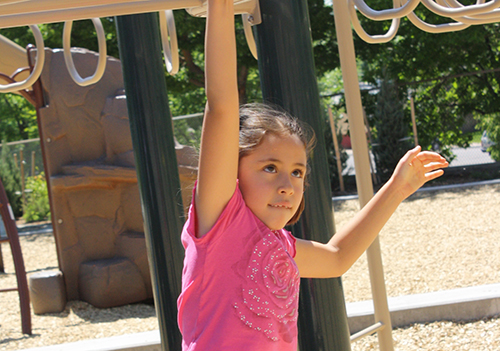Summary
Author: Pamela Wridt, Ph.D.
Date: December 2006 – December 2007
Funding Source: Robert Wood Johnson Foundation
An analysis of children’s use, negotiation and perceptions of their local environment for physical activity
Project Aims
This project used a mixed-method, participatory action research design to study children’s use of their local environment as it relates to their physical activity levels, with a particular emphasis on understanding the role of the Learning Landscape playgrounds as a safe and accessible community resource for children and their families. This research provides an analysis of how neighborhood physical and social processes mediate the impact of the Learning Landscape playgrounds on children’s physical activity from the perspective of children and their caretakers.
Research Objectives
Specific objectives were to: 1) study children’s use and perceptions of their local environment as it relates to their levels of physical activity; 2) examine caretaker norms and practices in relation to children’s use of their neighborhood as a support or barrier for physical activity; and 3) compare and contrast caretakers’ and children’s environmental perceptions to understand how children negotiate their use of the local environment for physical activity with caretakers.
Methods
This project was conducted in collaboration with two elementary schools in culturally diverse communities in Denver, CO, consisting of 48, 4th and 5th grade students. At one school, we worked with 12 students aged 10-11, a technology teacher and a parent-school liaison in an after school program. At another school, we worked with 36 students aged 10-11 and their 5th grade teacher during the school day. A variety of participatory and qualitative methods were employed in this research, including:
- Mapping – students worked in small groups using aerial photographs of their neighborhood to identify assets and risks in their community;
- Photography – students used disposable cameras to take pictures of places important to them in the neighborhood and discussed the significance of these places in their daily life
- Pedometers – students wore pedometers for a period of one week
- Time diary – students kept a diary of how they spent their time during a weekday and weekend, in addition to providing an inventory of their home and drawing images of their community
- Focus groups – a series of ongoing focus groups were conducted with students to involve them in the analysis of the data
- Production of children’s guide to physical activity – students helped design and produce a children’s guide to their neighborhood
- Community research – including archival research, Census data analysis, observations of public space, and school district data
- Field notes – researchers documented student comments and insights about their communities and our relations with the teachers, families and communities
- Dissemination of guidebook: at community events with parents and teachers and a special event with the Mayor of Denver
Results
Preliminary Results: The following variables appear to be influential in how children negotiate their local environment for incidental physical activity.
- Walkability: size of sidewalks, weather/heat index, distance to destinations for recreation, food and socialization, traffic density, size of street, time intervals of crossing signals, parental fears for children’s safety to cross street independently.
- Social hazards: teasing and bullying (often about different racial/cultural groups) and gang activity in alleys, parks and on school grounds, as well as the prevalence of liquor stores and their clientele.
- Community assets vs. risk factors supporting physical activities, such as a lack of neighborhood-based stores (food deserts) and recreational facilities within walking distance. Three dominant environmental socialization models were observed in our research with the children. These models were employed by caretakers, who consist of parents as well as extended family members. We will investigate the validity of these models with caretakers in Year 2.
- Restrictive models – in which children are “locked up” in their homes to protect them from the environment, primarily driven by fear of kidnapping or illegal immigration status. The restrictive models appear to be employed more frequently with girls than with boys.
- Training models – in which caretakers deliberately teach children about social and physical hazards in their communities and actively develop strategies to empower them to make informed decisions and safely negotiate their environment.
- Situational models – in which time, money, access to resources and trusted adults, knowledge of community opportunities and other variables that inhibit a caretaker’s ability to socialize children about the environment.

